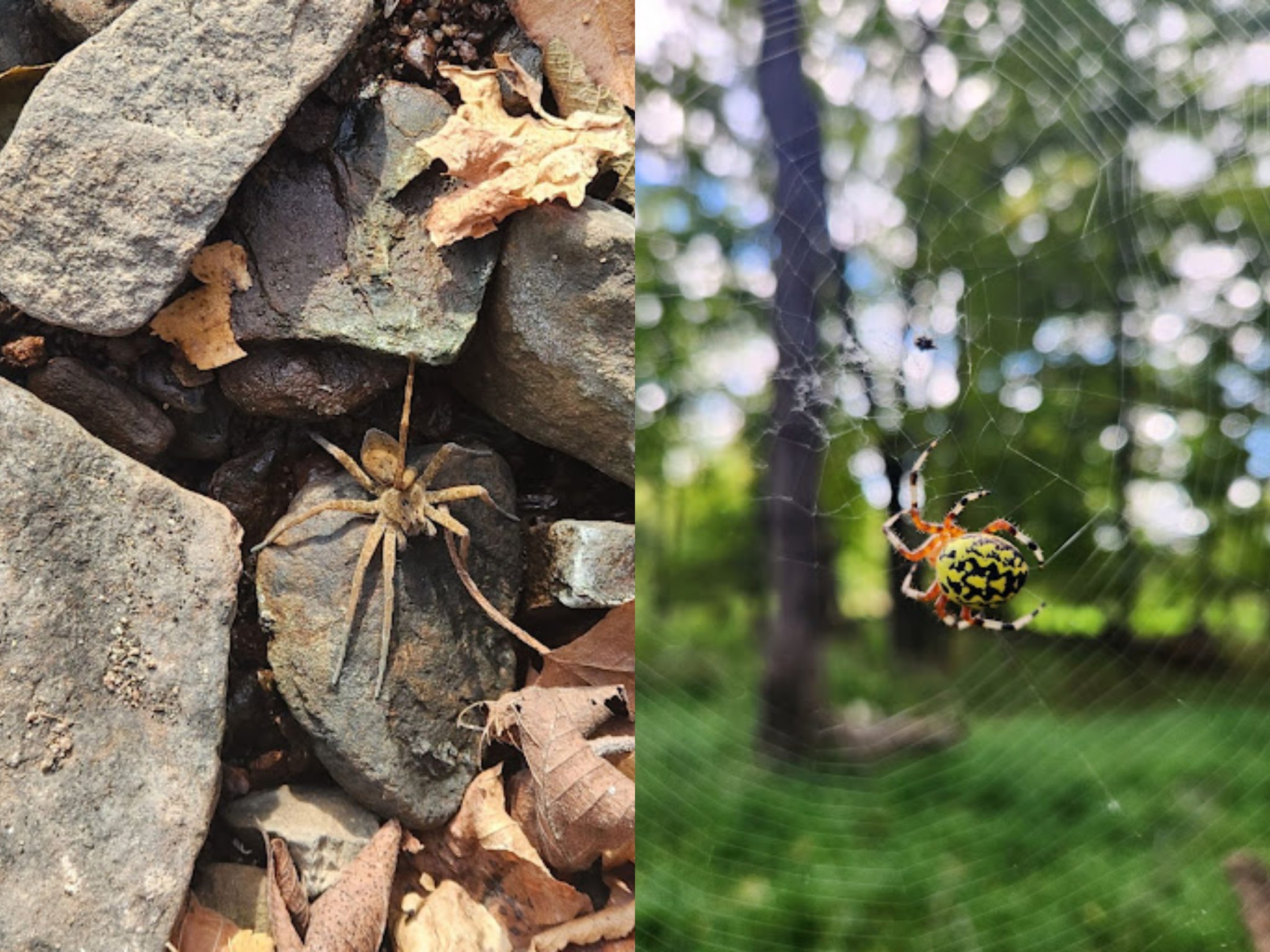When hiking, I usually don’t set out to find a cool spider, but when I stumble upon them, it sure is a treat! Arachnids are a vital component of our local ecosystems and some of them are pretty neat to look at, too. Here are five such species I’ve come across in Southeastern Pennsylvania.
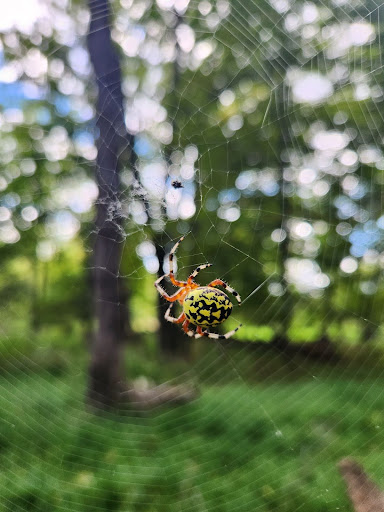
A female marbled orbweaver spins her web beside Cooks Creek in Springfield Township in September.
Marbled Orbweaver (Araneus marmoreus)
By far one of the prettiest spiders around to be found, in my opinion, the marbled orbweaver is the star of this list. The adult females are the showiest members of this species. Their round abdomens are typically a shade of yellow or orange with black-purple or brown markings, but it can also be nearly entirely white. The rest of the spider’s body, regardless of sex, is orange with striping and a color gradient along the legs. This patterning and color combination can be truly stunning against the green backdrop of its habitat, especially when the spider catches the late summer sun just right. The colorful adults can typically be found from midsummer until the first frost of fall. The females lay their eggs in October, hoping they will survive the winter well enough to hatch the following spring; a spring that the parent generation will not live to see.
This inhabitant of forested streambanks constructs a very classic spiderweb, usually between tree or shrub branches or between two tall forbes. Once the web is woven, the spider sits at the end of the signal strand, hidden under the cover of a leaf or similar camouflage, waiting for the strand to vibrate in indication that the spider has caught a meal. Maxing out at about 3/4s of an inch in length, these predators are really only threatening to the flying insects their webs are designed to catch and don’t pose any threat to humans.
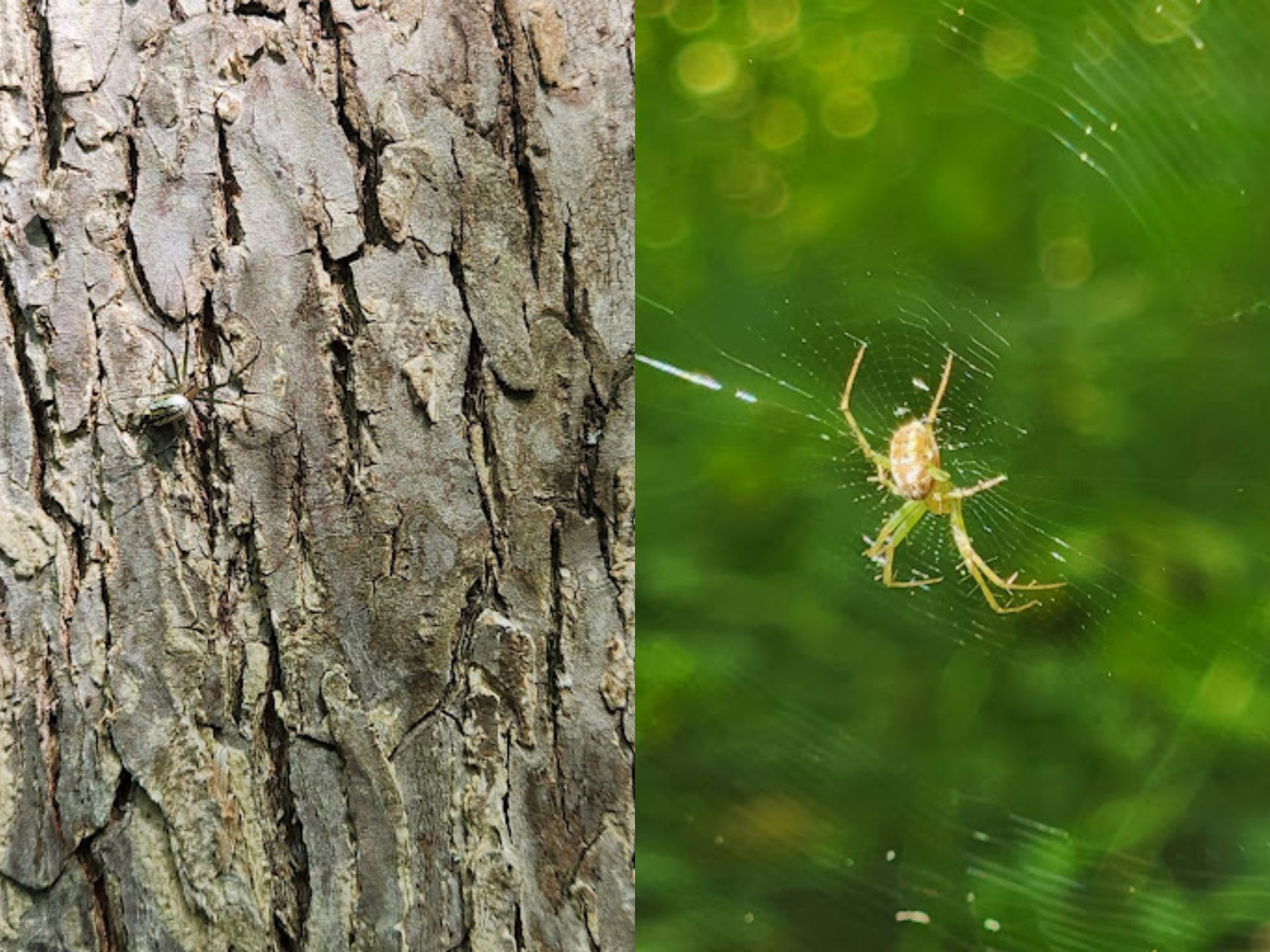
Left: An orchard orbweaver climbs up the bark of a tree in July. Right: A spider in the Mangora genus sits in the center of its web, waiting, in a forest in Durham Township in September.
Orchard Orbweaver (Leucauge venusta) and its cousin (Mangora sp.)
Other orbweaver-family spiders are also quite beautiful, like this orchard orbweaver (left) and this Mangora species (right). Focusing on the orchard orbweaver first, its common name is an apt description of where this spider weaves its fly-catching webs, while its scientific name translates to “beautiful bright gleam” – an apt description of how it catches your attention.
Beyond human-made orchards, this species of orbweaver typically lives in open shrublands and woodland edges. Unlike the marbled orbweaver, this spider sits at the center of its web as it waits for mosquitos or other insects to fly into its trap. So too does the Mangora species. The Mangora spider I came across had its web stretched between two woodland herbaceous plants at the edge of a small clearing in the forest created by fallen trees.
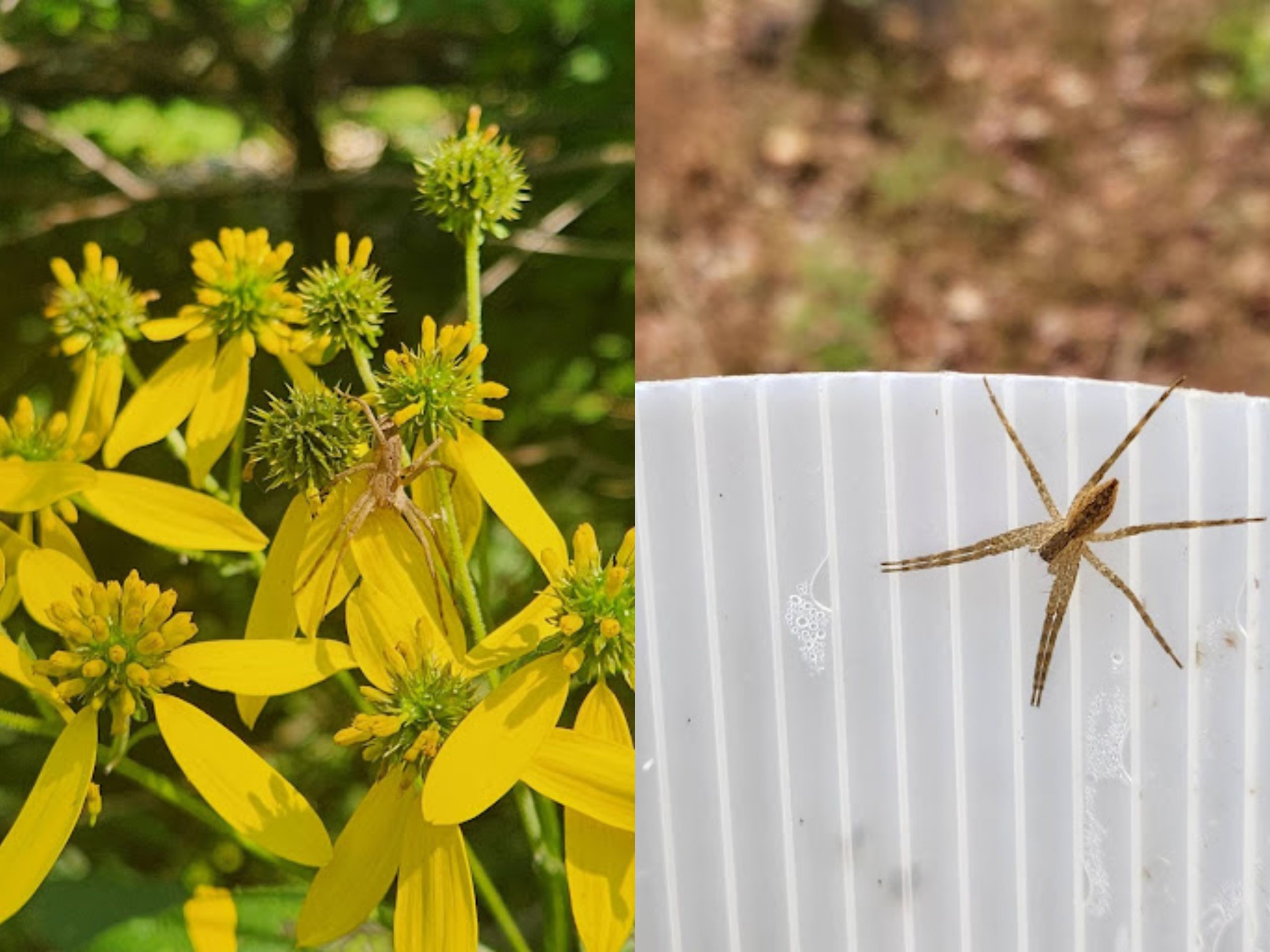
Left: Seen in Durham Township, an American nursery web spider waits in ambush on wingstem blossoms, hoping to grab small, easy prey coming to visit the flowers. Moments before taking this photo, however, I watched this spider flee from a bumblebee who was much too large for it to handle. Right: An American nursery web spider sits in it’s classic star formation atop a tree tube in Tinicum Township. Bottom: An American nursery web spider guards it’s egg sac beneath a leaf at Nockamixon State Park in July.
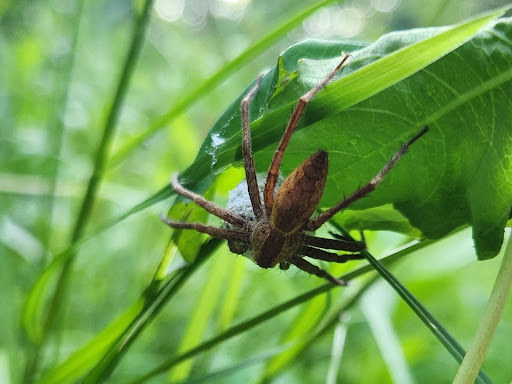
American Nursery Web Spider (Pisaurina mira)
This next spider is much less colorful, but I quite like its simplicity and the way it poses. The American nursery web spider is one of 500+ species in the nursery web spider family. This particular species is endemic to the eastern U.S., meaning that it is found nowhere else. Nursery web spiders, as their name suggests, only spin webbing to contain and protect their eggs. They will attach their silken egg sacs, first to the undersides of their own bodies and then to the underside of a leaf before hatching.
Without webs, these spiders must be ambush predators, rather than trappers. As a result, you may very well find them hanging out on flowers, waiting for an unsuspecting small pollinator like a flower fly or one of the smaller species of bees to fly by.
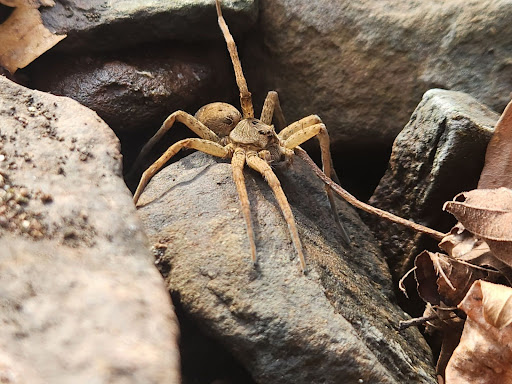
This banded fishing spider was found under a rock beside a small stream in Northampton Township in November, while a mixed flock of song birds, including some bluebirds, flitted through the treetops overhead.
Banded Fishing Spider (Dolomedes vittatus)
Preying on aquatic invertebrates and sometimes even small fish, this semi-aquatic spider lives up to its name. Banded fishing spiders are fast, capable of walking on water, and decently large for a spider. That said, these spiders may be a terror for a water-strider, but pose no real threat to humans. While they are capable of biting people, particularly the females when guarding their eggs, at worst this spider’s bite could cause momentary, slight pain and a small red welt that typically heals quickly on its own. And in their defense, humans are quite scary and capable of crushing them.
Like the nursery web spiders, the banded fishing spider does not weave a web for hunting purposes; rather, the females use their silk to wrap their eggs up and attach them first to the undersides of their body as they carry them around, and then to a rock or other hiding place as hatching time draws near. Also like the nursery web spider, this brown arachnid is not as bold as the first orbweavers, but there is something captivating about its size and stance.
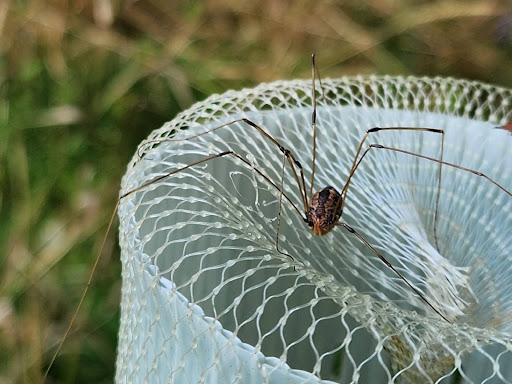
This eastern harvestman found on top of a tree tube in Springfield Township in August appears to have lost one of its back legs, perhaps in a close encounter with a predator.
Bonus Spider Imposter: Eastern Harvestman (Leiobunum vittatum)
While harvestmen are a type of arachnid, they are not actually spiders. More commonly known as daddy longlegs, these arachnids differ from spiders in several physiological ways, including:
- Harvestmen have a fused thorax and abdomen while spiders have segmented bodies.
- Harvestmen lack the venom and silk glands characteristic of spiders.
- Harvestmen tend to have much longer legs relative to their bodies than spiders.
To put their degree of evolutionary familiarity into perspective, harvestmen are as closely related to spiders as primates like us, gorillas, spider monkeys, and ring-tailed lemurs are to marsupials like possums, wombats, koalas, and kangaroos. Except that arachnids’ branch on the tree of life is almost twice as old as that of mammals.
So I include the eastern harvestman on this list mostly for its cultural association with spiders. This common harvestman deserves a moment in the spotlight, so that we all can appreciate its beauty and unique adaptations. You can find this species in a wide range of habitats, from forests to parks, from late spring to early fall.
Throughout the year, the sides of the harvestman’s body change color, from pale yellow to dark orange. During the warm months, they’ll be out looking for food. Their omnivorous diet includes plant fluids, fungi, plus insects and other arthropods either living or already dead. In this quest, harvestmen have eyes, but can’t see images, only sense the presence/absence of light. Instead, they rely on their second pair of legs, which are also the longest pair, to act like antennae and inform them of their surroundings. This pair of legs is absolutely vital to the creature’s survival, but the other six legs are all expendable. If caught, either by a predator or some unlucky foot placement, the harvestman can voluntarily amputate the trapped leg to get away, so long as it still has enough legs to walk.
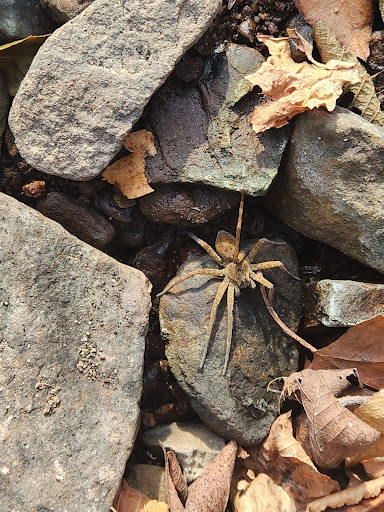
Spiders are Neat
I feel lucky to live in a place where all but one or two of our resident spiders are basically harmless and definitely ecologically beneficial. Arachnids get a bad rap sometimes, so I hope to inspire some curiosity rather than fear when it comes to spider encounters.
Our eight-legged neighbors spend their lives minding their own business and would rather not interact with us. But when we get the chance to meet, I recommend you pause and say hello. Take a closer look before leaving them alone. Notice their fancy patterns and beautiful colors. Generations of their ancestors have put their lives on the line in the evolution of these interesting bodies and lifestyles. Learn their names. Snap a photo, upload it to iNaturalist or similar app, and see who you have found. At the end of the day, you are wildly more likely to have made a new friend than to have had a painful experience.
The initial instinct to flinch away from unidentified creepy-crawlies can be strong, but I have found it meditative to push past that urge and remain calm and still. Don’t get me wrong, I still get grossed out when I unexpectedly walk through a spider web in the forest. But I try to move through the world with curiosity, rather than trepidation, suspicion, or hostility. Curiosity expands my world, draws me into both infinitely small details and impossibly large pictures. I invite you to join me in the practice of choosing curiosity.
Happy trails!
— Author Katie Toner is Heritage Conservancy’s Easement Stewardship Manager. All photos by Katie Toner.
